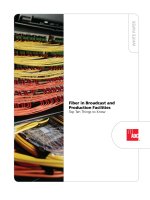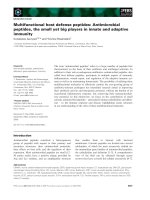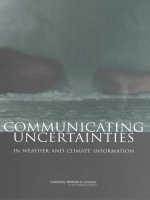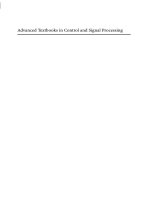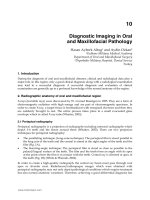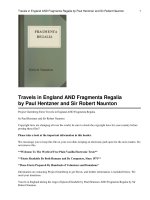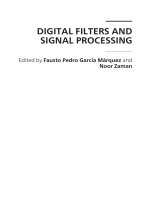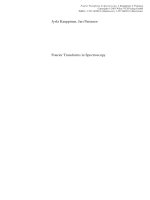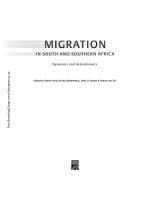Fourier Transforms in Radar And Signal Processing_2 docx
Bạn đang xem bản rút gọn của tài liệu. Xem và tải ngay bản đầy đủ của tài liệu tại đây (420.57 KB, 22 trang )
53
Pulse Spectra
spectral power factors (in both linear and logarithmic form) multiplying the
original pulse spectrum in the two cases, sinc
2
2f
for the rectangular pulse
and 1/[1 + (2
f
)
2
] for the stray capacitance. The power spectrum of the
smoothed pulse is that of the spectrum of the original pulse multiplied by
one of these spectra. Assuming the smoothing impulse response is fairly
short compared with the pulse length, the spectrum of the pulse will be
mainly within the main lobe of the impulse response spectrum. We see that
the side-lobe pattern of the pulse will be considerably reduced by the smooth-
ing (e.g., by about 10 dB at ±0.4/
from center frequency). We also see
that the rect pulse of width 2
gives a response fairly close to the stray
capacitance filter with time constant
.
3.7 General Rounded Trapezoidal Pulse
Here we consider the problem of rounding the four corners of a trapezoidal
pulse over different time intervals. This may not be a particularly likely
problem to arise in practice in connection with radar, but the solution to
this awkward case is interesting and illuminating, and could be of use in
some other application.
The problem of the asymmetrical trapezoidal pulse was solved in Section
3.4 by forming the pulse from the difference of two step-functions, each of
which was convolved with a rectangular pulse to form a rising edge. By
using different-width rectangular pulses, we were able to obtain different
slopes for the front and back edges of the pulse.
In this case we extend this principle by expressing the convolving rect
pulses themselves as the difference of two step functions. The (finite) rising
edge can then be seen to be the difference of two infinite rising edges, as
shown in Figure 3.14. Each of these, which we call Ramp functions, is
produced by the convolution of two unit step functions as shown in Figure
3.15 and defined in (3.20) below.
We define the Ramp function, illustrated in Figure 3.15, by
Ramp (t − T ) = h(t) ⊗ h(t − T ) (3.20)
so that
Ramp (t) =
ͭ
0 for t ≤ 0
t for t > 0
(t ∈ޒ) (3.21)
54 Fourier Transforms in Radar and Signal Processing
Figure 3.14 Rising edge as the difference of two Ramp functions.
55
Pulse Spectra
Figure 3.15 Ramp function.
(A different, finite, linear function is required in Chapter 6; this is called
ramp.) Having now separated the four corners of the trapezoidal pulse into
the corners of four Ramp functions, they can now all be rounded separately
by convolving the Ramp functions with different-width rect functions (or
other rounding functions, if required) as in Figure 3.11, before combining
to form the smoothed pulse. Before obtaining the Fourier transform of the
rounded pulse, we obtain the transform of the trapezoidal pulse in the form
of the four Ramp functions (two for each of the rising and falling edges).
In mathematical notation, the rising edge of Figure 3.14 can be
expressed in the two ways
h(t) ⊗ rect
ͩ
t − T
0
⌬T
ͪ
= h(t) ⊗ (Ramp (t − T
1
) − Ramp (t − T
2
))
(3.22)
The Fourier transform of the left side is, from P2a, P3a, R7b, R5, and
R6a,
ͫ
␦
( f )
2
+
1
2
if
ͬ
⌬T sinc f ⌬T exp (−2
ifT
0
) (3.23)
= ⌬T
ͫ
␦
( f )
2
+
sinc f ⌬T exp (−2
ifT
0
)
2
if
ͬ
where we have used
␦
( f − f
0
)u( f ) =
␦
( f )u( f
0
) in general, so
␦
( f ) sinc ( f ⌬T ) =
␦
( f ). The transform of the difference of the Ramp
functions on the right side is, using (3.20), P2a, R7b, and R6a,
ͫ
␦
( f )
2
+
1
2
if
ͬͭͫ
␦
( f )
2
+
1
2
if
ͬ
[exp (−2
ifT
1
) − exp (−2
ifT
2
)]
ͮ
(3.24)
56 Fourier Transforms in Radar and Signal Processing
Using T
0
and ⌬T as given in Figure 3.14, the difference of the expo-
nential terms becomes exp (−2
ifT
0
)(exp (2
if ⌬T ) − exp (−2
if ⌬T )) or
2i sin (2
f ⌬T ) exp (−2
ifT
0
), so again using
␦
( f − f
0
)u( f ) =
␦
( f )u ( f
0
)
[with u( f
0
) = sin (0) in this case], (3.24) becomes
ͫ
␦
( f )
2
+
1
2
if
ͬͭͫ
␦
( f )
2
+
1
2
if
ͬ
2i sin (
f ⌬T ) exp (−2
ifT
0
)
ͮ
=
ͫ
␦
( f )
2
+
1
2
if
ͬ
sin (
f ⌬T ) exp (−2
ifT
0
)
f
(3.25)
=
ͫ
␦
( f )
2
+
1
2
if
ͬ
⌬T sinc ( f ⌬T ) exp (−2
ifT
0
)
which is the same as (3.23), as expected.
We are now in a position to find the spectrum of the trapezoidal pulse
shown in Figure 3.16, with different roundings of each corner. This pulse
is separated, as shown, into four Ramp functions and has rising and falling
edges of width ⌬T
r
and ⌬T
f
, centered at T
r
and T
f
, respectively. The edges,
formed from pairs of Ramp functions, are normalized to unity by dividing
by the width ⌬T
r
or ⌬T
f
. (They certainly have to be scaled to the same
height if the initial and final levels are to be the same.) Thus this pulse is
given by
1
⌬T
r
[Ramp (t − T
1
) − Ramp (t − T
2
)] (3.26)
−
1
⌬T
f
[Ramp (t − T
3
) − Ramp (t − T
4
)]
To round a corner we replace Ramp (t − T
k
)byr
k
(t) ⊗ Ramp (t −
T
k
), where r
k
(t) is a rounding function of unit integral (such as the rect
pulse in Figure 3.11). For a function with this property, it follows that R(0)
= 1, where R is the Fourier transform of r; this is shown by
Figure 3.16 Unit height trapezoidal pulse.
57
Pulse Spectra
͵
∞
−∞
r(t) dt = 1 =
͵
∞
−∞
r(t) e
−
2
ift
dt
|
f
=
0
= R(0) (3.27)
The rounded rising edge, given by e
r
(t) = [r
1
(t) ⊗ Ramp (t − T
1
) −
r
2
(t) ⊗ Ramp (t − T
2
)]/⌬T
r
, can be written, from the definition of Ramp
in (3.20),
e
r
(t) = h(t) ⊗ [r
1
(t) ⊗ h(t − T
1
) − r
2
(t) ⊗ h(t − T
2
)]/⌬T
r
(3.28)
with transform
E
r
( f ) =
1
⌬T
r
ͫ
␦
( f )
2
+
1
2
if
ͬ
и
ͭͫ
␦
( f )
2
+
1
2
if
ͬ
[R
1
( f ) exp (−2
ifT
1
) − R
2
( f ) exp (−2
ifT
2
)]
ͮ
=
ͫ
␦
( f )
2
+
1
2
if
ͬ
и
ͭ
[R
1
( f ) exp (
if ⌬T
r
) − R
2
( f ) exp (−
if ⌬T
r
)]
2
if ⌬T
r
exp (−2
ifT
r
)
ͮ
=
ͭ
␦
( f )
2
+
[R
1
( f ) exp (
if ⌬T
r
) − R
2
( f ) exp (−
if ⌬T
r
)]
(2
if )
2
⌬T
r
ͮ
exp (−2
ifT
r
)
(3.29)
following the approach of the nonrounded case above [(3.23) to (3.25)].
Combining the two edges, the
␦
-functions disappear, as in forming the
spectrum of the asymmetric pulse in Section 3.4 [(3.10) and (3.11)], to give
the final result for the spectrum of the generally rounded trapezoidal pulse:
−
ͫ
R
1
( f )e
if
⌬
T
r
− R
2
( f )e
−
if
⌬
T
r
ͬ
(2
f )
2
⌬T
r
e
−
2
ifT
r
(3.30)
+
ͫ
R
3
( f )e
if
⌬
T
s
− R
4
( f )e
−
if
⌬
T
s
ͬ
(2
f )
2
⌬T
s
e
−
2
ifT
s
58 Fourier Transforms in Radar and Signal Processing
As a check, we note that if we used a single rounding function r, with
transform R, the expression in (3.30) reduces to
R( f )
ͩ
sinc f ⌬T
r
2
if
e
−
2
ifT
r
−
sinc f ⌬T
s
2
if
e
−
2
ifT
s
ͪ
(3.31)
which (with T
r
=−T/2, T
s
= T/2, ⌬T
r
=
1
, and ⌬T
s
=
2
) is seen, from
(3.11), to be exactly the result of smoothing the asymmetrical trapezoidal
pulse with the function r.
3.8 Regular Train of Identical RF Pulses
This waveform could represent, for example, an approximation to the output
of a radar transmitter using a magnetron triggered at regular intervals. The
waveform is defined by
u(t) = rep
T
[rect (t/
) cos 2
f
0
t ] (3.32)
where the pulses of length
of a carrier at frequency f
0
are repeated at the
pulse repetition interval T and shown in Figure 3.17.
We note that the rep operator applies to a product of two functions,
so the transform will be (by R8b) a comb version of a convolution of the
transforms of these functions. We could express the cosine as a sum of
exponentials, but more conveniently we use P7a in which this has already
been done. Thus (from P3a, P8a, R8b, and R5) we obtain
U( f ) = (
/2T ) comb
1/T
[sinc ( f − f
0
)
+ sinc ( f + f
0
)
] (3.33)
This spectrum is illustrated (in the positive frequency region) in Figure 3.18.
Thus we see that the spectrum consists of lines (which follows from
the repetitive nature of the waveform) at intervals 1/T, with strengths given
Figure 3.17 Regular train of identical RF pulses.
59
Pulse Spectra
Figure 3.18 Spectrum of regular RF pulse train.
by two sinc function envelopes centered at frequencies f
0
and −f
0
.As
discussed in Chapter 2, the negative frequency part of the spectrum is just
the complex conjugate of the real part (for a real waveform) and provides
no extra information. (In this case the spectrum is real, so the negative
frequency part is just a mirror image of the real part.) However, as explained
in Section 2.4.1, the contribution of the part of the spectrum centered at
−f
0
in the positive frequency region can only be ignored if the waveform is
sufficiently narrowband (i.e., if f
0
>> 1/
, the approximate bandwidth of
the two spectral branches).
An important point about this spectrum, which is very easily made
evident by this analysis, is that, although the envelope of the spectrum is
centered at f
0
, there is, in general, no spectral line at f
0
. This is because
the lines are at multiples of the pulse repetition frequency (PRF) (1/T ), and
only if f
0
is an exact multiple of the PRF will there be a line at f
0
. Returning
to the time domain, we would not really expect power at f
0
unless the carrier
of one pulse were exactly in phase with the carrier of the next pulse. For
there to be power at f
0
, there should be a precisely integral number of
wavelengths of the carrier in the repetition interval T ; that is, the carrier
frequency should be an exact multiple of the PRF. This is the case in the
next example.
3.9 Carrier Gated by a Regular Pulse Train
This waveform would be used, for example, by a pulse Doppler radar. A
continuous stable frequency source is gated to produce the required pulse
train (Figure 3.19). Again we take T for the pulse repetition interval,
for
60 Fourier Transforms in Radar and Signal Processing
Figure 3.19 Carrier gated by a regular pulse train.
the pulse length, and f
0
for the carrier frequency. The waveform is given
by
u(t) = [rep
T
(rect t/
)] cos 2
f
0
t (3.34)
and its transform, shown in Figure 3.20, is (using R7a, R8b, P3a, and P7a)
U( f ) = (
/2T ) comb
1/T
(sinc f
) ⊗ [
␦
( f − f
0
) +
␦
( f + f
0
)]
(3.35)
Denoting the positive frequency part of the spectrum by U
+
and
assuming the waveform is narrowband enough to give negligible overlap of
the two parts of the spectrum, we have
U
+
( f ) = (
/2T ) comb
1/T
(sinc f
) ⊗
␦
( f − f
0
) (3.36)
The function comb
1/T
sinc f
is centered at zero and has lines at
multiples of 1/T, including zero. Convolution with
␦
( f − f
0
) simply moves
the center of this whole spectrum up to f
0
. Thus there are lines at f
0
+ n/T
Figure 3.20 Spectrum of regularly gated carrier.
61
Pulse Spectra
(n integral, −∞ to ∞), including one at f
0
. In general, there is no line at
f = 0; this is only the case if f
0
is an exact multiple of 1/T. Unlike the
previous case, we would expect the waveform to have power at f
0
,asthe
pulses all consist of samples of the same continuous carrier at this frequency.
3.10 Pulse Doppler Radar Target Return
In this case we take the radar model to be a number of pulses with their
amplitudes modulated by the beam shape of the radar as it sweeps past
the target. Here, for simplicity, we approximate this modulation first by a
rectangular function of width
(i.e.,
is the time on target). A more realistic
model will be taken later. The transmitted waveform (and hence the received
waveform, from a stationary point target) is given, apart from an amplitude
scaling factor, by
x(t) = rect (t/
)u(t ) (3.37)
where u (t) is given in (3.34) above. The spectrum (from R7a, P3a, and R5)
is
X(t) =
sinc f
⊗ U( f ) (3.38)
where U is given in (3.35). The convolution effectively replaces each
␦
-function in the spectrum U by a sinc function. This is of width 1/
(at
the 4-dB points), which is small compared with the envelope sinc function
of the spectrum, which has width 1/
, and also is small compared with the
line spacing 1/T if
>> T (i.e., many pulses are transmitted in the time on
target). In fact there will also be a Doppler shift on the echoes if the target
is moving relative to the radar. If it has a relative approaching radial velocity
v, then the frequencies in the received waveform should be scaled by the
factor (c + v)/(c − v), where c is the speed of light. This gives an approximate
overall spectral shift of +2vf
0
/c (assuming v << c and the spectrum is
narrowband, so that all significant spectral energy is close to f
0
or −f
0
).
Figure 3.21 illustrates the form of the spectrum of the received signal.
Stationary objects (or ‘‘clutter’’) produce echoes at frequency f
0
and at
intervals n/T about f
0
, all within an envelope defined by the pulse spectrum
(as in Figure 3.20). The smaller, moving target echoes produce lines offset
from the clutter lines, so that such targets can be seen, as a consequence of
their relative movement, in the presence of otherwise overwhelming clutter.
62 Fourier Transforms in Radar and Signal Processing
Figure 3.21 Spectrum of pulse Doppler radar waveform.
(Figure 3.21 is diagrammatic; the filter bank may be at baseband or
a low IF, and may be realized digitally. By suitable filtering, not only can
the targets be seen, but an estimate is obtained of the Doppler shift and
hence of the target radial velocity.)
As indicated by (3.38), all the lines are broadened by the spectrum of
the beam modulation response. In Chapter 7 we will see that, for a linear
aperture, the beam shape is essentially the inverse Fourier transform of the
aperture illumination function, and with a constant angular rotation rate, this
becomes the beam modulation. (We require the small angle approximation
sin
␣
≈
␣
, which is generally applicable in the radar case.) The transform
of this will give essentially the same function as the illumination function.
Thus, if this is chosen to be, for example, the raised cosine function (as in
Section 3.5) to give moderately low side lobes (Figure 3.10), then the lines
will be spread by a raised cosine function, also.
3.11 Summary
The spectra of a number of pulses and of pulse trains have been obtained
in this chapter using the rules-and-pairs method. As remarked earlier, the
aim is not so much to provide a set of solutions on this topic as to illustrate
the use of the method so that users can become familiar with it and then
solve their own problems using it. Thus, whether all the examples correspond
demonstrably to real problems (for example, finding the spectra of the
63
Pulse Spectra
asymmetric trapezoidal pulse and, particularly, this pulse with different
roundings of each corner) is not the question—the variety of possible user
problems cannot be anticipated, after all—but rather whether the examples
demonstrate various ways of applying the method to yield solutions neatly
and concisely without any explicit integration.
4
Sampling Theory
4.1 Introduction
In this chapter we use the rules-and-pairs notation and technique to derive
several sampling theorem results, which can be done very concisely in some
cases. In fact, the wideband (or baseband) sampling theorem and the Hilbert
sampling theorem for narrowband (or RF and IF) waveforms are obtained
here following the derivations of Woodward [1]. Two other narrowband
sampling techniques, uniform sampling and quadrature sampling, have been
analyzed by Brown [2], but these results have been obtained here much
more easily using Woodward’s approach and have been extended to show
what sampling rates are acceptable, rather than just giving the minimum
sampling rates presented by Brown.
Woodward’s technique is to express the spectrum U of the given
waveform u in a repetitive form, then gate it to obtain the spectrum again.
The Fourier transform of the resulting identity shows that the waveform
can be expressed as a set of impulses of strength equal to samples of the
waveform, suitably interpolated. This is the converse of repeating a waveform
to obtain a line spectrum: if a waveform is repeated at intervals T, a spectrum
is obtained consisting of lines (
␦
-functions in the frequency domain) at
intervals F = 1/T with envelope U, the spectrum of u. Conversely, if a
spectrum U is repeated at intervals F, we obtain a waveform of impulses
(
␦
-functions in the time domain) at intervals T = 1/F with envelope u , the
(inverse) transform of U. The problem in this case is to express the spectrum
precisely as a gated repetitive form of itself. In general, this can only be done
65
66 Fourier Transforms in Radar and Signal Processing
by specifying that U should have no power outside a certain frequency
interval, and that there should be no overlapping when U is repeated. (In
one case below, that of quadrature sampling, overlapping is allowed, provided
a condition is met, but again this is for the case of a strictly band-limited
spectrum.) This finite bandwidth condition is not a completely realizable
one—it corresponds to an infinite waveform—but can be interpreted as the
condition that U should have negligible power (rather than no power) outside
the given band. The values that are ‘‘negligible’’ will depend on the system
and are not analyzed here. However, the approach used here can be used
to determine, or at least to estimate, the effect of spectral overlap, which is,
in fact, aliasing.
Brown’s approach is to express the waveform u as an expansion in
terms of orthogonal time functions. In fact, these orthogonal functions are
just the set of displaced interpolating functions of the Woodward approach,
the interpolating function being the Fourier transform of the spectral gating
function. It is necessary to show that this set of functions, which varies with
the sampling technique used, is complete. This method is rather complicated
compared with Woodward’s, which can use the standard results for Fourier
series using sets of complex exponential, or trigonometrical, functions. Fur-
thermore, the Woodward approach seems generally easier to understand and
so to modify or apply to other possible sampling methods.
4.2 Basic Technique
First we present the basic technique that is used in subsequent sections to
derive the sampling theory results. Because a regularly sampled waveform,
which is the ultimate target, has a repetitive spectrum, we repeat the spectrum
U of the given waveform u at frequency intervals F, then gate (or filter) this
spectrum to obtain U again. This identity is then Fourier transformed to
produce an identity between the waveform and an interpolated sampled
form of itself. Because this is an identity, it means that all the information
in the original waveform u is contained in the sampled form. (The definition
of the interpolating function is also needed if it is required to reconstitute
the analogue waveform u .) In symbols we write
U( f ) = rep
F
U( f )G( f ) (4.1)
u(t) = (1/F ) comb
1/F
u(t) ⊗ g(t) (4.2)
67
Sampling Theory
where G( f ) is the spectral gating function and g (t) is its transform (i.e.,
the impulse response of a filter with frequency response G ).
Now the comb function consists of a set of impulse responses
(
␦
-functions) at intervals T = 1/F of strength equal to the value of the
function u at the instant of the impulse:
comb
T
u(t) = ⌺u(nT )
␦
(t − nT ) (4.3)
The convolution of a function g with a
␦
-function simply transfers the origin
of g to the position of the
␦
-function. Thus (4.2) and (4.3) give, with T =
1/F,
u(t) = T comb
T
u(t) ⊗ g(t) = T ⌺u(nT )
␦
(t − nT ) ⊗ g (t) (4.4)
= T ⌺u(nT )g(t − nT )
This makes clear the identity between u and its sampled form, correctly
interpolated.
In the following sections of this chapter, the starting point is (4.1),
choosing the appropriate sampling frequency F and spectral gating function
G in the different cases. The basic problem is to express U in terms of a
gated repetitive form of itself, where the repetition frequency F is chosen
so that no spectral overlapping occurs. We are primarily concerned with
determining F, which is the required sampling rate, and are less concerned
with the gating function G, except that we need to know that a suitable
function exists to establish the identity (4.1). The actual form of the interpo-
lating function g is not required, in general; again, it is sufficient to know
that it exists, but generally reconstituting the waveform from its samples will
not be required. In Sections 4.3 and 4.4 below (wideband and uniform
sampling), we simply repeat the spectrum of u. In Section 4.5 (Hilbert
sampling), we also include the spectrum of u
ˆ
, the Hilbert transform of u
and in Section 4.6 (quadrature sampling) we include a quarter wave delayed
form of u. The sampling techniques of Sections 4.4 and 4.6 are for nar-
rowband waveforms—signals on a carrier.
4.3 Wideband Sampling
By a wideband waveform u we mean a waveform containing energy at all
frequencies from zero up to some maximum W beyond which there is no
68 Fourier Transforms in Radar and Signal Processing
spectral energy. A real waveform has a complex spectrum U which is complex
conjugate symmetric about zero, so real waveforms of interest have spectra
within the interval [−W, W ] (Figure 4.1). If we repeat this spectrum at
intervals 2W, it will not overlap, as there is no spectral energy outside this
interval, so we can write the identity
U( f ) = rep
2W
U( f ) rect ( f /2W ) (4.5)
where we have equated the spectrum to a gated portion of the repeated form
of the spectrum itself (Figure 4.1). Taking the Fourier transform, we obtain
u(t) = comb
1/2W
u(t) ⊗ sinc 2Wt (4.6)
This is the particular form of (4.2) for this sampling case. This equation
states that u is equal to itself sampled at a rate of 2W (i.e., at intervals T =
1/2W ) and correctly interpolated, the interpolating function in this case
being 2W sinc 2Wt . The equivalent form of (4.4) is
u(t) = ⌺u(nT ) sinc (t − nT ) (4.7)
and the equivalence of the waveform to its interpolated sampled form is
illustrated in Figure 4.2.
It is clear (from Figure 4.1, for example) that if we repeat the spectrum
at intervals 2W ′, where W ′>W, we still obtain the spectrum U on gating
with either 2W or 2W ′ bandwidth. Thus, any sampling rate greater than
2W is also adequate.
Figure 4.1 Gated repeated waveform.
69
Sampling Theory
Figure 4.2 Sampled waveform with interpolating functions.
Thus we have the wideband sampling theorem:
If a real waveform has no spectral energy above a maximum frequency
W, then all the information in the waveform is retained by sampling
it at a rate 2W (or higher).
In principle, reconstituting the waveform in this case is achieved by
driving a rectangular bandwidth low-pass filter with impulses of strength
proportional to the sample values and at the sample times. In practice, an
approximation to u could be formed easily as a boxcar waveform from the
sample values [simply holding the value u(nT ) constant over the interval
[nT,(n + 1)T ]. Smoothing this with a low-pass filter would give a better
approximation to u.
4.4 Uniform Sampling
4.4.1 Minimum Sampling Rate
We define a real narrowband (or IF) waveform as one that has negligible
power outside a frequency band W centered on a carrier frequency f
0
, where
W /2 < f
0
. (The complex spectrum of a real IF waveform consists of two
bands centered at +f
0
and −f
0
. We label these U
+
and U
−
as before, for
convenience, as shown in Figure 4.3.) For such a waveform, it is not necessary
to sample at twice the maximum frequency (i.e., at 2f
0
+ W here), as in the
case of a wideband waveform, but at approximately twice the bandwidth.
We initially restrict W so that the upper edge of the signal band f
u
is
an integer multiple of W ; that is, f
u
= f
0
+ W /2 = kW for k integral. The
lower edge of the band is then at (k − 1)W. The spectrum can now be
70 Fourier Transforms in Radar and Signal Processing
Figure 4.3 Narrowband spectrum.
repeated at intervals 2W without overlap as 2f
0
= (2k − 1)W, so a displacement
of 2kW or 2(k − 1)W moves the spectral band U
−
, centered at −f
0
, adjacent
to the band U
+
at f
0
without overlapping it (Figure 4.4). Thus, we can
write
U( f ) = rep
2W
U( f )
ͭ
rect
ͫ
( f − f
0
)
W
ͬ
+ rect
ͫ
( f + f
0
)
W
ͬͮ
(4.8)
again representing U as a gated repeated form of itself. The transform of
this equation is
u(t) =
1
2W
comb
1/2W
u(t) ⊗ W sinc Wt(e
2
if
0
t
+ e
−
2
if
0
t
) (4.9)
Thus u is equal to itself sampled at a rate 2W and interpolated by the
function sinc Wt cos(2
f
0
t), which is the impulse response of an ideal
rectangular band-pass filter of bandwidth W centered at frequency f
0
.
We now remove the condition relating f
0
and W. We note that a
spectrum within a band ( f
u
− W, f
u
) is also within the band ( f
u
− W ′,
f
u
)ifW ′≥W. Thus, if W does not satisfy the condition f
u
= kW (k integral),
we choose the smallest W ′>W that does satisfy it. More specifically, if f
u
= (k +
␣
)W where 0 ≤
␣
< 1, we choose W ′ so that f
u
= kW ′, and we can
write k = [ f
u
/W ], where [x ] means the largest integer contained in x.
Then repeating the spectrum at intervals 2W ′ again produces a nonover-
Figure 4.4 Allowed spectral shifts.
71
Sampling Theory
lapping spectrum (Figure 4.5), but this time with some gaps [of size
2(W ′−W )] due to the difference between W ′ and W.
It is clear that to regain U
+
from the part of the spectrum shown in
Figure 4.5, it is only necessary to gate with the same gating function as
before [given in (4.8)—gates of width W centered at +f
0
and −f
0
] leading
to the same interpolating function, sinc Wt cos(2
f
0
t). Brown [2] in effect
uses the more complicated interpolating function sinc (2W ′t ) cos 2
f
0
′t
where f
0
′=f
0
− (W ′−W )/2. This corresponds to using the gating function
rect [( f − f
0
′)/W ′], which will also gate out U
+
as required (Figure 4.6) but
is more complicated than necessary.
4.4.2 General Sampling Rate
The minimum sampling rate 2f
u
/k, found in the previous section, is such
that the band U
−
shifted by 2kW ′ is just above U
+
when the repetitive
spectrum is formed (Figure 4.5). If W ′ is increased above this value, this
band will move up in frequency, and so will the band U
−
, shifted by
2(k − 1)W ′, which will eventually start to overlap U
+
. This will define a
(local) maximum allowed sampling rate, and this occurs when 2(k − 1)W ′
= 2f
l
, where f
l
is the frequency at the lower edge of the signal band (Figure
4.7). Thus, the allowed sampling rate 2W ′ ranges from a minimum value
2f
u
/k to a maximum 2f
l
/(k − 1). As k is defined here by f
u
= (k +
␣
)W,
we also have f
l
= f
u
− W = (k − 1 +
␣
)W, and we see that the range of
allowed sampling rates 2W ′ is given by
Figure 4.5 rep
2w
U ( f ) near +f
0
.
Figure 4.6 Selecting U (f ).
72 Fourier Transforms in Radar and Signal Processing
Figure 4.7 Maximum sampling rate.
2f
u
/k = 2(k +
␣
)W /k ≤ 2W ′≤2(k − 1 +
␣
)W /(k − 1) = 2f
l
/(k − 1)
(4.10)
It is convenient to define a relative sampling rate r as the actual rate
divided by the minimum value possible (to retain all the signal data) 2W,
so that the allowed relative rate 2W ′/2W becomes
(k +
␣
)/k ≤ r ≤ (k − 1 +
␣
)/(k − 1) (4.11)
or
1 +
␣
/k ≤ r ≤ 1 +
␣
/(k − 1) (4.12)
If the sampling rate is increased above the ‘‘maximum’’ 2f
l
/(k − 1),
we see from Figure 4.7 that U
−
will overlap U
+
until the rate rises to 2f
u
/
(k − 1) when we reach a new local minimum value for the allowed sampling
rate. The rate can now be increased to a new local maximum 2f
l
/(k − 2)
before overlap starts again. In general, we see that allowed relative sampling
rates are given by
(k +
␣
)/n ≤ r ≤ (k − 1 +
␣
)/(n − 1) (n = k, k − 1, ,1)
(4.13)
(In the n = 1 case, we only have a minimum rate; the maximum rate
in this case is unbounded.) Putting n = k gives the absolute minimum rate,
1 +
␣
/k. The allowed relative sampling rates are given in the shaded regions
of Figure 4.8 as a (multivalued) function of the center frequency normalized
to the bandwidth.
We note from Figure 4.8 that the lowest range of allowed rates becomes
very narrow at high values of f
0
/W. This indicates that the sampling rate
should be carefully chosen in this case, and perhaps should be synchronized
to some frequency in the signal band. The minimum rate is in fact defined
by f
u
, but there is no actual signal power here (from the definition of W ),
73
Sampling Theory
Figure 4.8 Relative sampling rates (uniform sampling).
so it would be more convenient to use f
0
. The allowed band of relative
rates, from (4.12), is between 1 +
␣
/k and 1 +
␣
/(k − 1), so 1 +
␣
/
(k −
1
⁄
2
) would be near the mean of these. The actual rate with this choice
is thus 2W (k +
␣
−
1
⁄
2
)/(k −
1
⁄
2
) = 2( f
u
− W /2)/(k −
1
⁄
2
) = 2f
0
/(k −
1
⁄
2
).
This rate is indicated by the dashed lines and is very close to the minimum
rate for higher values of f
0
/W (e.g., above 3
1
⁄
2
).
We note that if f
0
/W =
1
⁄
2
, we have effectively a wideband waveform
of positive frequency bandwidth W (see Figure 4.3), with positive frequencies
extending from 0 to W. The uniform sampling rate in this case is 2W (see
Figure 4.8), which agrees with the result in Section 4.3 for a wideband
waveform. We also note that the minimum rate is substantially different
from 2W only for large fractional bandwidths (W /f
0
large and so f
0
/W
small). For small fractional bandwidths of, for example, a few percent, which
is often the case for radio and radar signals, whether at high, very high,
ultra-high, or microwave frequencies, the correct rate will be very close to
2W, and setting it actually at 2W will generally give negligible degradation.
Finally, we state a simplified form of the uniform sampling theorem for
narrowband waveforms, which is not as neatly defined as for the wideband
case:
If a real waveform has no spectral energy outside a frequency band of
width W centered on a carrier of frequency f
0
= (k −
1
⁄
2
+
␣
)W (k
integral, 0 ≤
␣
< 1), then all the information in the waveform is retained
by sampling it at a rate 2rW, where r is given in (4.13) above.
74 Fourier Transforms in Radar and Signal Processing
4.5 Hilbert Sampling
Given a real waveform u , the complex waveform v = u + iu
ˆ
has a spectrum
consisting of positive frequency components only, where u
ˆ
is the Hilbert
transform of u, defined in Appendix 4A. For narrowband waveforms, a 3-dB
coupled line directional coupler is a very good approximation to a Hilbert
transformer, which generates u
ˆ
from u. (The Hilbert transformer effectively
produces a wideband 90-degree phase shift; see Appendix 4A.) The two
outputs of such a coupler are a Hilbert transform pair, which may be
considered to form a complex waveform, if the rules for complex arithmetic
are observed when processing this two-channel waveform.
If W is the band (centered on −f
0
and f
0
) outside which U has negligible
power, then we can see that V is within a band of width W, centered on
+f
0
only, and so can be repeated at intervals W without overlapping (Figure
4.9). Thus, we can write the identity
V ( f ) = rep
W
V ( f ) rect [( f − f
0
)/W ] (4.14)
Performing the inverse Fourier transform using P3b, R8a, R6b, and R5, we
obtain
v(t) = (1/W ) comb
1/W
v(t) ⊗ [W sinc Wt exp (2
if
0
t)] (4.15)
Now u is the real part of v, so taking the real part of both sides we obtain
u(t) = comb
1/W
u(t) ⊗ (sinc Wt cos 2
f
0
t) − comb
1/W
u
ˆ
(t) (4.16)
⊗ (sinc Wt sin 2
f
0
t)
We see that u is equal to a combination of samples of u and u
ˆ
appro-
priately interpolated, the samples being taken at intervals 1/W (i.e., at a
rate W ). We also note that by taking the imaginary part of v from (4.15),
we obtain the sampled form of u
ˆ
. If we repeat the spectrum at intervals
W ′>W, corresponding to sampling at the rate W ′, we still have a nonoverlap-
Figure 4.9 rep
W
V ( f ) near +f
0
.

